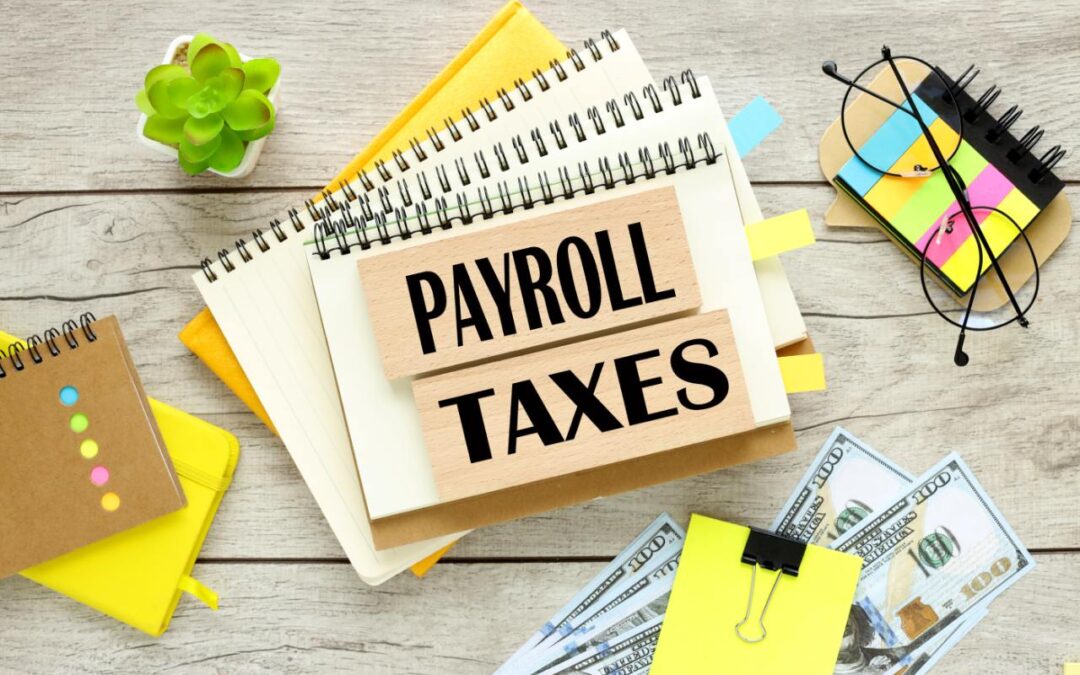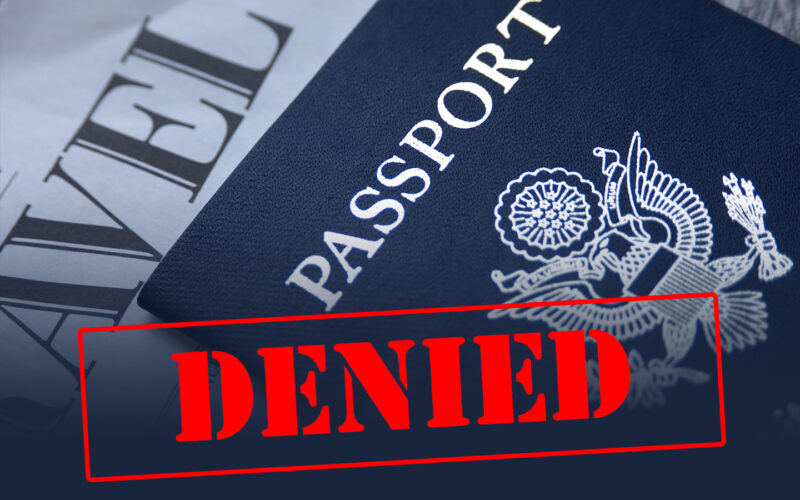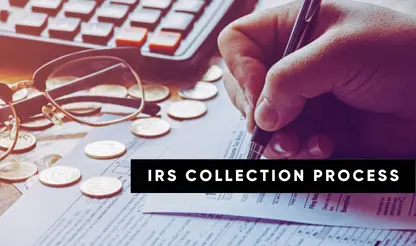
by Renee Lawson | Dec 15, 2025 | Tax Preparation, Tax Resolution
If you’re a small business owner behind on payroll taxes, you’re not alone. Most fall behind due to cash-flow issues or tough decisions made under pressure. But payroll tax debt escalates quickly.
Because payroll taxes include money withheld from employees—“trust fund” taxes—the IRS treats them as highly serious and moves fast to collect.
The good news: with the right representation, you can protect your business and resolve the problem.
This article explains what happens when you owe payroll taxes, how the IRS responds, and what you can do before the situation becomes critical. If you have any questions after reading this you can contact Action Tax Relief by calling 937-268-2737 or by going to www.ActionTaxRelief.com.
Why Payroll Taxes Are So Serious
When you withhold Social Security, Medicare, and federal income taxes from employees, the IRS views that as money you’re holding in trust for them. If those deposits aren’t made on time, the IRS treats it as if the government was deprived of its money—intentionally.
To the IRS, this is no longer just a tax issue. It’s a compliance failure.
And because payroll tax shortages usually signal broader financial distress—cash-flow shortages, declining sales, borrowing from payroll to pay vendors—the IRS sees it as a business and taxpayer at risk.
The IRS Responds Fast – Much Faster Than With Income Taxes
If you owe back 941 payroll taxes, the timeline can escalate faster than almost any other tax issue.
Here’s what typically happens:
1. You Miss a Deposit Deadline
Even one missed deposit can cause the IRS to flag your account. If you miss multiple deposits, the IRS system automatically triggers notices.
2. IRS Letters Start Arriving
This usually begins with notices showing the missed deposit, accrued penalties, and interest. These penalties are some of the highest in the tax code—up to 15% just for missing the deposit deadline.
3. The IRS Assigns a Revenue Officer (RO)
When payroll taxes are not paid for multiple quarters, your case often gets assigned to a Revenue Officer—an IRS field collection agent with significant authority.
When that happens, the matter becomes serious. Revenue Officers will:
- Show up at your business unannounced
- Request extensive financial records
- Interview you and key employees
- Demand immediate payment or a plan
- Move quickly to enforce collection if you don’t respond
4. The Trust Fund Recovery Penalty (TFRP) Investigation Begins
This is the biggest surprise many business owners face.
If payroll trust fund taxes weren’t paid, the IRS can personally assess the Trust Fund Recovery Penalty (TFRP) against any responsible individual—including owners, officers, shareholders, check-signers, or anyone with authority over finances.
This means the IRS can collect the trust fund portion of the debt from your personal assets—your bank accounts, wages, retirement accounts, even your home in extreme cases.
You’ll be asked to sit for a Form 4180 interview. What you say in that interview will determine whether you are personally assessed tens or hundreds of thousands of dollars in penalties.
5. IRS Levies and Liens Can Happen Quickly
If you don’t respond—or you miss deadlines—the IRS can take immediate steps to collect:
- Levy business bank accounts
- Seize accounts receivable
- Garnish your personal or business wages
- Shut down merchant accounts
- In rare cases, seize business assets
A payroll tax case can move from “late deposit” to “levy action” in a matter of weeks or months.
Most employers don’t fall behind because they’re reckless. It usually happens because:
- A major expense hit unexpectedly
- A recession or downturn crushed cash flow
- You kept employees on payroll longer than you should have
- You were trying to save the business during a rough patch
But the IRS doesn’t consider these mitigating circumstances. Payroll taxes are considered a fiduciary duty. From their perspective, once you fall behind, you’re a risk that needs immediate intervention.
That’s why you need someone protecting you from the very first letter.
Don’t Wait – Payroll Tax Problems Get Worse, Not Better
If you’re behind on payroll taxes—even one quarter—you are in one of the highest-risk categories in the eyes of the IRS. The longer the problem goes unaddressed, the fewer options you have and the more aggressive the IRS becomes.
But with expert help, the situation is absolutely manageable.
If your business owes payroll taxes—or you’ve received notices, a visit from a Revenue Officer, or a Trust Fund Recovery Penalty letter contact Action Tax Relief at www.ActionTaxRelief.com or call 937-268-2737 to schedule a consultation with an experienced tax resolution specialist.
We’ll protect your business, negotiate with the IRS, and design a resolution strategy that helps you move forward with confidence. Your business—and your peace of mind—are worth it.

by Renee Lawson | Dec 8, 2025 | Tax Preparation, Tax Resolution
When you fall behind on your taxes, the notices, penalties, and IRS pressure can escalate fast. A financial setback, medical issue, or unexpected emergency is often all it takes to get behind—and once collections start, many taxpayers feel they have nowhere to turn.
Most people believe their only options are to fully repay the balance or hope they qualify for an Offer in Compromise (OIC). But the IRS has another option—one they rarely highlight—that can provide real relief: the Partial Payment Installment Agreement (PPIA).
A PPIA lets you make affordable monthly payments even if those payments won’t pay off the full balance before the IRS’s 10-year collection statute expires. When that deadline hits, the remaining debt is forgiven. It’s a middle ground between a standard installment agreement and an OIC—without the strict qualification rules.
At Action Tax Relief we have experience negotiating partial pay installment agreements for our clients. If you need help negotiating a PPIA with the IRS you can contact us at www.ActionTaxRelief.com or call 937-268-2737.
What Is a Partial Payment Installment Agreement?
A Partial Payment Installment Agreement is a payment plan where you agree to pay a reduced monthly amount that will not fully pay your balance before the IRS’s time to collect (the 10-year CSED) expires. After that deadline, the IRS legally must stop collecting, and the unpaid portion of your tax debt disappears.
This makes a PPIA a lifeline for taxpayers who cannot afford the higher payment required under a normal installment agreement and who may not qualify for an Offer in Compromise.
Why the IRS Offers This Option
The IRS knows that some taxpayers simply cannot pay their full balance—ever. Taking all their income or forcing asset liquidation isn’t always realistic and can push individuals into financial hardship.
A PPIA allows the IRS to:
- Collect something rather than nothing
- Avoid forcing taxpayers into bankruptcy
- Keep individuals compliant going forward
- Reduce the administrative burden of aggressive enforcement
In short, a PPIA is the IRS’s way of acknowledging that full collection may be impossible.
Who Qualifies for a PPIA?
A PPIA is ideal for individuals who:
- Cannot full-pay the total tax balance before the statute expires
- Cannot afford the monthly payment required under a normal installment agreement
- Do not qualify for an Offer in Compromise
- Have limited income or high allowable living expenses
- Have minimal assets or equity
- Would experience financial hardship if forced to pay more
To evaluate eligibility, the IRS analyzes:
- Necessary living expenses
- Equity in assets (home, cars, investments, etc.)
- Current and future ability to pay
The IRS’s goal is to determine your reasonable collection potential (RCP)—a calculation of what you can realistically afford each month.
How the IRS Calculates Your Monthly Payment
The IRS uses strict financial guidelines to figure out your required monthly payment. They consider:
- Your allowable expenses (which are capped by IRS standards)
- Your projected ability to pay over time
A tax resolution specialist can help ensure:
- All allowable expenses are counted
- Your assets are valued properly
- Your income is analyzed correctly
- You are not forced into a payment you cannot sustain
Without representation, people often agree to payments that are far too high.
The IRS Re-Evaluates PPIAs Every Two Years
Once approved, a PPIA is not “set and forget.” The IRS reviews your financial situation every two years to determine whether:
- Your payment should increase
- Your situation has worsened
- The agreement should continue as is
These reviews can be stressful without a professional defending your numbers, especially if your income increases.
Why a PPIA Can Be Life-Changing
A Partial Payment Installment Agreement can dramatically ease the burden of IRS debt because your monthly payment is based on what you can truly afford—not the total amount you owe. This protects your income and savings while giving you a realistic path forward. Once a PPIA is in place, levies and garnishments stop, allowing you to rebuild financially without constant IRS pressure. And since any remaining balance is forgiven when the collection statute expires, many taxpayers end up paying far less than their total debt. For individuals facing large balances and limited resources, a PPIA is often the most practical alternative to bankruptcy and one of the few options that provides long-term relief without financial devastation.
Final Thoughts
If you owe IRS tax debt and cannot afford to pay it in full, a Partial Payment Installment Agreement may be the relief you’ve been searching for. Our tax resolution firm can determine whether you qualify, negotiate directly with the IRS, and secure the lowest possible payment so you can finally move forward.
Contact Action Tax Relief at www.ActionTaxRelief.com or call 937-268-2737to schedule a confidential consultation today.

by Renee Lawson | Nov 3, 2025 | Tax Preparation, Tax Resolution
When you file a joint tax return with your spouse, you’re both saying to the IRS: We’re in this together. That means both of you are jointly and severally liable for any tax owed—even if the unpaid balance, errors, or fraud were entirely your spouse’s doing.
It’s one of the most misunderstood and frightening parts of the tax code. Imagine finding out years later that your ex (or soon-to-be ex) underreported income or claimed fake deductions—and now the IRS wants to collect from you.
The good news? The tax law gives you a way out, known as Innocent Spouse Relief. This powerful but complex program can protect you from paying taxes, interest, and penalties caused by your spouse’s (or former spouse’s) wrongdoing. If you qualify, the IRS can legally remove your liability—freeing you from a tax mess you didn’t create.
Let’s unpack what it is, how it works, and how a tax resolution professional can help you navigate it successfully. And if you have any questions after reading this you can contact Action Tax Relief by calling 937-268-2737 or by going to www.ActionTaxRelief.com.
What Is Innocent Spouse Relief?
Innocent Spouse Relief is part of IRC §6015, designed for people who filed joint returns but shouldn’t be held responsible for a spouse’s errors or fraud.
It comes in three forms:
- Innocent Spouse Relief (§6015(b)) – You didn’t know, and had no reason to know, of an understatement on the joint return.
- Separation of Liability Relief (§6015(c)) – You’re divorced, legally separated, or no longer living with your spouse, and want to separate your share of tax.
- Equitable Relief (§6015(f)) – When the first two don’t fit, but fairness says you shouldn’t be held liable.
Each has unique requirements, but they all aim to prevent you from being punished for a spouse’s wrongdoing.
Why Joint Liability Can Be So Dangerous
The IRS doesn’t care who earned the income or made the mistake. When you file jointly, they can pursue 100% of the debt from either spouse.
If your spouse has:
- Claimed bogus deductions, or
- Failed to pay self-employment or investment taxes
The IRS can levy your bank account, garnish wages, or seize refunds, even if you were completely unaware. That’s why Innocent Spouse Relief can be life-changing.
Who Qualifies?
To qualify for Innocent Spouse Relief, you generally must show that:
- You filed a joint return with an understatement of tax due to your spouse’s erroneous items,
- You didn’t know or have reason to know about it, and
- It would be unfair to hold you liable.
For Separation of Liability Relief, you must be divorced, legally separated, widowed, or living apart for at least 12 months.
Equitable Relief covers cases where abuse, control, or other hardships make liability unfair. The IRS looks at:
- Whether you were abused or coerced,
- Whether you benefited from the unpaid tax, and
- Whether you tried to fix the problem once discovered.
Every case is fact-specific, and documentation matters.
How to Apply
You request relief by filing Form 8857, Request for Innocent Spouse Relief.
After filing, the IRS must notify your spouse or ex-spouse, giving them a chance to respond (though your address is kept private).
The review process can take six months to two years. If denied, you can appeal within 30 days or take your case to the U.S. Tax Court.
Common Real-Life Scenarios
- Hidden Income: Your spouse ran a side business and didn’t report the income.
- Fake Deductions: You didn’t know they made up business or charitable expenses.
- Abuse or Coercion: You were pressured to sign the return under duress.
- Divorce Surprise: You discover after separation that taxes weren’t paid years earlier.
In all these cases, Innocent Spouse Relief may wipe out the IRS debt or shift responsibility solely to your spouse.
Why Work With a Tax Resolution Professional
Filing Form 8857 isn’t as simple as sending paperwork—it’s a legal and strategic process. You must prove your lack of knowledge and fairness under IRS standards.
A qualified tax resolution expert can:
- Identify which relief option fits best,
- Build your case with evidence and statements,
- Communicate with the IRS so you don’t have to, and
- Protect you from collection actions while your case is pending.
If full relief isn’t possible, a professional can explore other options such as an Offer in Compromise or Currently Not Collectible status.
The Bottom Line
No one should pay for someone else’s tax mistakes—especially if you were deceived or kept in the dark. Innocent Spouse Relief exists to restore fairness and give you a fresh start.
If you’ve received IRS notices tied to your spouse’s tax debt or divorce, don’t ignore them. The longer you wait, the harder it becomes to fix—and there are strict time limits for requesting relief.
Need Help?
If you believe you qualify for Innocent Spouse Relief, or you’re unsure how to respond to an IRS letter, we can help.
Our firm specializes in tax resolution and IRS representation, guiding clients through Innocent Spouse, Offer in Compromise, and other relief programs every day.
We’ll review your case, explain your options, and fight to protect your financial future. Contact Action Tax Relief at www.ActionTaxRelief.com or call 937-268-2737 to schedule a consultation with an experienced tax resolution specialist.
You don’t have to face the IRS—or your spouse’s tax problems—alone.

by Renee Lawson | Oct 20, 2025 | Tax Preparation, Tax Resolution
Cryptocurrency has gone from niche hobby to mainstream investment in just a few short years. Millions of Americans now buy, sell, and trade digital assets like Bitcoin, Ethereum, and countless altcoins. But along with explosive growth in crypto markets comes a less glamorous reality: the IRS wants its share of your profits—and it’s getting better at finding out when you haven’t paid.
If you’ve traded crypto and failed to report your gains, or if you’re unsure whether you calculated your taxes correctly, you could be facing back taxes, penalties, and interest. The good news? With the right strategy and timely action, you can resolve crypto-related tax issues before they spiral out of control.
In this blog we will discuss what you need to know about how the IRS treats cryptocurrency and what steps to take if you owe back taxes on crypto gains. At Action Tax Relief we specialize in helping businesses and individuals in resolving their tax debt. You can contact us at www.ActionTaxRelief.com or call 937-268-2737.
How the IRS Views Cryptocurrency
First, it’s important to understand the IRS’s position: cryptocurrency is treated as property, not currency, for federal tax purposes. This classification has been in place since IRS Notice 2014-21, and it means that every time you sell or exchange crypto—whether for U.S. dollars, another cryptocurrency, or goods and services—you trigger a capital gain or loss.
Key implications:
- Capital Gains Taxes: If you sell crypto for more than you paid, you realize a capital gain. Short-term gains (held for one year or less) are taxed at ordinary income rates, while long-term gains enjoy lower capital gains rates.
- Capital Losses: Losses can offset other gains and up to $3,000 of ordinary income annually.
- Income from Mining or Staking: Rewards earned through mining, staking, or airdrops are treated as ordinary income at their fair market value when received.
This means crypto activity can create multiple taxable events throughout the year—not just when you “cash out” to fiat currency.
How the IRS Is Tracking Crypto Activity
Some investors assume crypto is anonymous and hard to trace. That’s no longer true. The IRS has ramped up enforcement significantly:
- Exchange Reporting: Major U.S.-based exchanges (like Coinbase, Kraken, and others) issue Form 1099 to the IRS and account holders for certain transactions.
- Blockchain Analysis: The IRS partners with blockchain analytics firms to track transactions on public ledgers.
- Tax Return Question: Every individual tax return now asks whether you engaged in any digital asset transactions during the year.
The IRS’s message is clear: crypto transactions are visible, and failing to report them can lead to serious trouble.
Common Reasons People Owe Back Taxes on Crypto Gains
Crypto taxes can get complicated fast, and even well-intentioned investors can end up with a tax bill. Some common scenarios include:
- High Volume Trading: Day trading crypto across multiple exchanges can generate hundreds or thousands of taxable events—easy to underreport.
- Failure to Track Cost Basis: Without accurate records of purchase price and dates, it’s difficult to calculate gains or losses correctly.
- Not Reporting Mining or Staking Rewards: These are treated as income when received and can create tax obligations even if you don’t sell the coins.
- Price Volatility: Selling crypto after a big run-up may result in large taxable gains, even if the market crashes later.
If you’ve made any of these mistakes, you may already owe the IRS back taxes.
Consequences of Owing Crypto-Related Back Taxes
The IRS treats unpaid crypto taxes the same way it treats any other unpaid taxes. Possible consequences include:
- Penalties and Interest: Failure-to-file and failure-to-pay penalties can add up quickly, along with daily interest charges.
- Tax Liens and Levies: If you don’t address your balance, the IRS can file a federal tax lien against your property or levy (seize) your bank accounts, wages, or other assets.
- Criminal Charges in Extreme Cases: Deliberate tax evasion—such as hiding crypto holdings—can lead to criminal prosecution.
The longer you wait, the more severe and costly these consequences become.
Steps to Take if You Owe Back Taxes on Crypto Gains
If you discover or suspect that you owe taxes on your cryptocurrency activities, here are the steps to take:
1. Gather All Transaction Records
Collect data from every exchange or wallet you’ve used, including trade histories, purchase dates, amounts, and fees. Tools such as crypto tax software can help consolidate this information.
2. Calculate Your Tax Liability
You’ll need to determine your cost basis and capital gains or losses for each transaction. If you’ve received mining or staking rewards, calculate the fair market value when received.
3. File or Amend Your Tax Returns
If you failed to report crypto transactions on previous tax returns, file amended returns (Form 1040-X) for those years. This is often a critical step in demonstrating good faith to the IRS.
4. Pay What You Can
Paying the full amount immediately will stop penalties from accruing. If you can’t pay in full, send as much as possible to reduce interest and penalties.
5. Explore IRS Resolution Options
The IRS offers programs to help taxpayers resolve back taxes, including:
- Installment Agreements: Monthly payment plans that spread out your tax debt.
- Offer in Compromise (OIC): Settle your debt for less than the full amount if you qualify.
- Currently Not Collectible Status: If you’re in financial hardship, the IRS may temporarily suspend collection.
A tax resolution professional can help you evaluate which option fits your circumstances.
6. Respond Promptly to IRS Notices
If you’ve received IRS letters regarding unreported crypto income or unpaid taxes, respond immediately. Ignoring notices will only escalate the problem.
How to Stay Compliant Going Forward
Once you’ve addressed your back taxes, put systems in place to avoid future problems:
- Use Reliable Crypto Tax Software: Track every transaction throughout the year.
- Keep Detailed Records: Maintain records of purchase prices, dates, and any fees.
- Make Estimated Tax Payments: If you trade frequently, consider quarterly estimated payments to avoid surprises at tax time.
- Consult a Tax Professional: Work with a CPA or tax resolution specialist experienced in cryptocurrency taxation.
Don’t Wait for the IRS to Catch Up
Crypto is no longer the Wild West. The IRS has the tools and partnerships to track digital asset transactions, and enforcement is increasing each year. If you owe back taxes, it’s far better to come forward voluntarily than to wait for the IRS to contact you. Voluntary disclosure often results in reduced penalties and demonstrates good faith.
Final Thoughts
The IRS treats cryptocurrency just like other property—and failing to report your gains can lead to significant back taxes, penalties, and potential legal action. Whether you traded Bitcoin once or are an active DeFi participant, the time to address unreported crypto gains is now.
Need Professional Help With Crypto-Related Tax Debt?
Action Tax Relief specializes in helping individuals and businesses resolve tax debt—including issues related to cryptocurrency gains. Contact us at 937-268-2737 or visit our contact page at www.ActionTaxRelief.com to schedule a confidential consultation and take the first step toward putting your crypto tax problems behind you.

by Renee Lawson | Oct 6, 2025 | Tax Preparation, Tax Resolution
When people think of the Internal Revenue Service (IRS), they often picture audits, liens, or wage garnishments. But many are surprised to learn that the IRS can also impact your ability to travel internationally. Under a federal law passed in 2015, the IRS can ask the U.S. Department of State to deny, revoke, or limit your passport if you have a “seriously delinquent tax debt.”
For anyone who travels for business, visits family overseas, or simply enjoys international vacations, this is more than an inconvenience—it’s a serious risk that can disrupt your life and livelihood. In this blog we will cover everything you need to know about how the passport revocation process works, how to protect yourself, and what steps to take if you receive a notice. At Action Tax Relief we specialize in helping both individuals and businesses resolve their tax debt. If you need help you can contact us at www.ActionTaxRelief.com or call 937-268-2737.
What Is “Seriously Delinquent Tax Debt”?
The key trigger for passport action is a “seriously delinquent tax debt,” which is defined by law under Internal Revenue Code Section 7345. As of 2025, this means:
- You owe more than $59,000 in unpaid federal taxes (including penalties and interest), AND
- A federal tax lien has been filed or a levy has been issued.
This threshold is indexed for inflation and can change each year, but it represents a significant amount of debt. Importantly, not every large tax bill counts. If you’re actively working with the IRS on a resolution, you may be exempt.
How the Passport Revocation Process Works
- IRS Certifies the Debt:
The IRS identifies taxpayers who meet the “seriously delinquent” criteria and sends their names to the U.S. Department of State. At the same time, the IRS sends you a written notice—Notice CP508C—to your last known address.
- Department of State Action:
Once the IRS certifies your debt, the State Department can:
- Deny your application for a new passport or renewal.
- Revoke your existing passport.
- Limit your passport to allow only direct return to the United States.
The process is not instantaneous. Typically, the State Department gives you 90 days after receiving the certification to resolve your tax issue before revoking your passport. However, if you are applying for a passport or attempting to renew, they can deny your application right away.
Situations That Are NOT Considered “Seriously Delinquent”
The IRS does not certify taxpayers to the State Department if:
- You are in a valid installment agreement or offer in compromise.
- You have a pending request for either of the above.
- You have filed for innocent spouse relief.
- You are a victim of tax-related identity theft.
- You live in a federally declared disaster area, or the debt is currently uncollectible due to hardship.
These exceptions mean that if you are proactive about working with the IRS, you can avoid passport problems entirely—even if you owe more than the threshold.
Warning Signs You Could Be at Risk
The IRS doesn’t certify debt without sending notices. But many taxpayers miss these warnings because they:
- Moved without updating their address.
- Ignored IRS mail out of fear or confusion.
- Thought they had more time to respond.
If you’ve been receiving IRS collection letters (such as CP14, CP501, or CP503) and your tax debt is climbing, you could be on the path toward a CP508C notice.
Consequences of Passport Revocation
Having your passport denied or revoked can be far more than an inconvenience:
- Business Travel: If your work requires international travel, losing your passport can jeopardize contracts and income.
- Family Emergencies: You could be unable to visit sick relatives or attend important events abroad.
- Leisure Travel: Planned vacations may need to be canceled, often at significant financial loss.
And while the State Department usually provides a 90-day window to resolve the debt before revocation, it can deny a pending passport application immediately. That means you may not even be able to leave the country for a planned trip.
How to Avoid or Stop Passport Revocation
If you receive a CP508C notice or suspect you’re close to the threshold, take action quickly:
1. Verify the Notice
Double-check that the IRS’s certification is correct. Sometimes payments or credits have not yet posted. You can contact the IRS directly or have a tax professional request your account transcript.
2. Pay the Debt in Full
Paying the entire balance—including penalties and interest—will cause the IRS to reverse the certification, usually within 30 days. While this is the fastest path, it’s not realistic for everyone.
3. Enter Into an Installment Agreement
If you can’t pay in full, set up a formal installment agreement with the IRS. Once approved, the IRS will withdraw the certification and notify the State Department.
4. Submit an Offer in Compromise
If you qualify for an Offer in Compromise (OIC) to settle your debt for less than the full amount, the IRS will reverse the certification once your OIC is pending and again if it’s accepted.
5. Request Currently Not Collectible (CNC) Status
If you can prove financial hardship, the IRS may place your account in CNC status, which also stops passport revocation.
6. Appeal the Certification
If you believe the IRS certified your debt in error, you can request a judicial review in U.S. Tax Court or federal district court.
What to Expect After You Resolve the Debt
Once you’ve paid or made arrangements, the IRS will notify the State Department within 30 days to remove the certification. The State Department will then reinstate your passport privileges.
However, this process is not instantaneous. If you have imminent international travel, inform the IRS and the State Department of your travel plans. In rare emergencies, the State Department may issue a limited passport for direct return to the U.S., but only in very specific situations.
Conclusion
International travel is a privilege many people take for granted until it’s at risk. If you have significant tax debt, don’t wait until you’re at the airport to find out there’s a problem. Address your tax situation early and get professional help if needed.
Need Professional Tax Debt Help?
Action Tax Relief specializes in helping individuals and businesses resolve tax debt and avoid consequences like passport revocation. Contact us at 937-268-2737 or visit our contact page at www.ActionTaxRelief.com to schedule a confidential consultation and take the first step toward resolving your IRS problems today.

by Renee Lawson | Sep 22, 2025 | Tax Preparation, Tax Resolution
Dealing with the IRS collection process can feel overwhelming and intimidating, especially if you’re unfamiliar with how it works. Whether you owe back taxes or have received a notice from the IRS, understanding the steps in the collection process can help you make informed decisions. This blog will break down the process, explain what to expect, and highlight some ways to resolve tax issues before they escalate.
Step 1: The IRS Notice
The IRS collection process begins when the agency identifies that you owe taxes. They will send a written notice, often referred to as a “CP” notice, explaining the amount owed, the tax year in question, and any applicable penalties and interest. The notice will also provide a deadline for payment or response.
It is crucial to read this notice carefully and respond promptly. Ignoring IRS notices will not make the problem go away; instead, it may lead to more severe consequences, such as additional penalties or enforcement actions.
Key Takeaway: Always open and read letters from the IRS. Ignoring them will only worsen your situation.
Step 2: IRS Billing Notices
If you don’t respond to the initial notice, the IRS will send additional billing notices. These notices will outline the increasing balance due, including interest and penalties. Typically, you will receive three to four notices over several months before the IRS escalates collection efforts.
The final billing notice, known as a “Final Notice of Intent to Levy,” is particularly critical. This notice informs you that the IRS intends to seize your assets if you do not take action. The IRS is required to provide you with 30 days to appeal or resolve the issue before moving forward with enforcement actions.
Pro Tip: If you receive a Final Notice of Intent to Levy, don’t wait. Contact a tax resolution expert immediately to explore your options.
Step 3: Collection Actions Begin
Once the IRS determines that the debt is unresolved, they may initiate collection actions. Here are some of the most common methods:
- Tax Liens: A tax lien is a legal claim against your property (real estate, personal property, or financial assets). While it doesn’t involve immediate seizure, it can harm your credit score and make it difficult to sell or refinance property.
- Wage Garnishment: The IRS can contact your employer and require them to withhold a portion of your paycheck to satisfy your tax debt. This is often referred to as a “wage levy.”
- Bank Levies: A bank levy allows the IRS to seize funds directly from your bank account. Once the levy is issued, the bank freezes your account and forwards the funds to the IRS after 21 days unless you resolve the debt.
- Seizure of Assets: In rare cases, the IRS may seize physical assets, such as your home, car, or other valuables, to satisfy unpaid tax debt.
Important Note: The IRS’s ability to collect through liens, levies, and asset seizures is powerful, but you have rights and options to protect yourself.
Step 4: Options for Resolving Tax Debt
Fortunately, the IRS offers several programs to help taxpayers resolve their debts. Here are some of the most common solutions:
Installment Agreements
An installment agreement allows you to pay your tax debt in monthly installments over time. This can help make large tax bills more manageable. Depending on your situation, you may qualify for a streamlined agreement that requires minimal financial documentation.
Offer in Compromise (OIC)
An Offer in Compromise allows you to settle your tax debt for less than the full amount owed. To qualify, you must demonstrate that paying the full amount would create a financial hardship. The IRS considers factors such as income, expenses, and asset equity when evaluating OIC applications.
Currently Not Collectible (CNC) Status
If you can’t afford to pay your tax debt due to financial hardship, you may qualify for “Currently Not Collectible” status. While in CNC status, the IRS temporarily suspends collection efforts. However, penalties and interest will continue to accrue on your balance.
Innocent Spouse Relief
If your tax debt is the result of errors or omissions made by your spouse (or former spouse) on a joint tax return, you may qualify for innocent spouse relief. This program can relieve you of responsibility for the tax debt associated with your spouse’s mistakes.
Tip: Each of these options requires specific qualifications and documentation. Working with a tax resolution professional can help ensure your application is accurate and complete.
Step 5: Your Rights as a Taxpayer
The IRS must follow strict rules when collecting taxes, and you have rights throughout the process. These include:
- The Right to Be Informed: The IRS must provide clear explanations of your tax obligations and any actions they intend to take.
- The Right to Challenge the IRS: You have the right to appeal IRS decisions, such as liens or levies, if you believe they are incorrect or unfair.
- The Right to Retain Representation: You have the right to work with a tax professional to help resolve your case.
- The Right to a Fair and Just Tax System: The IRS must consider your financial situation and ability to pay when taking collection actions.
Why You Should Act Now
Ignoring tax debt won’t make it disappear. In fact, delays can lead to increased penalties, interest, and enforcement actions. By addressing the issue early, you can explore options to reduce your debt, prevent aggressive collection actions, and regain financial stability.
If you’re unsure where to start, don’t worry. Action Tax Relief specializes in helping individuals and businesses resolve their tax issues quickly and efficiently. Contact us at 937-268-2737 or visit our contact page at www.ActionTaxRelief.com to schedule a consultation today.
Final Thoughts
The IRS collection process can be stressful, but understanding how it works is the first step toward resolving your tax issues. From responding to notices to exploring resolution options, taking proactive steps can help you avoid unnecessary financial strain and protect your assets.
Remember, you don’t have to navigate this process alone. With the right help and guidance, you can overcome your tax challenges and achieve peace of mind.






